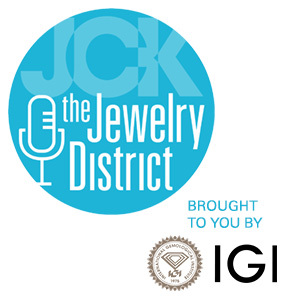
On this week’s episode, JCK editor-in-chief Victoria Gomelsky and news director Rob Bates discuss the colored gem shows in Tucson, where designers were buzzing over Guatemalan jade. Rob updates listeners on big news from De Beers, which sealed a 10-year deal with Botswana and saw its value written down significantly. In other news, one of Signet’s largest shareholders has called for a sale of the company. Rob offers insights into the factors driving these headline-making stories. Finally, Victoria reports on the state of the Swiss watch industry as Audemars Piguet marks its 150th anniversary.
Listen Now
Sponsored by IGI: igi.org/education
Episode Credits
Hosts: Rob Bates and Victoria Gomelsky
Producer and engineer: Natalie Chomet
Editor: Riley McCaskill
Plugs: @jckmagazine; igi.org/education
Show Notes
03:54 Tucson takeaways
09:39 Big news (and questions) about De Beers
14:33 Signet filing sparks speculation
17:30 Audemars Piguet turns 150
Show Recap
Tucson takeaways
Victoria reports on the Tucson gem shows. This was a quiet year, she says, compared with the buzzy, lively shows of recent years, when the colored stone business and the jewelry industry in general were booming during and following the pandemic. “That isn’t to say people weren’t selling,” she says, noting that some vendors reported big-ticket sales that made up for the less crowded aisles.
“The coolest thing I saw…there is a fresh supply of an ancient material—and it’s Guatemalan jade, and it comes from the Motagua River valley,” Victoria adds. (Look for more news on this in JCK’s May issue.)
Victoria recalls seeing a lot of striking dark blue–toned jade in shops when she visited the colonial town of Antigua, Guatemala, in 2002. The supply in Tucson was a similar color—a translucent blue-green. “Tons of designers were really responding to” it, she says. “It did feel like there was some momentum behind that material, which is always fun. Tucson is very hit or miss, mostly miss if you’re looking for new things, [so] to have a new find that really feels important is pretty rare.”
Rob wonders what caused the slower traffic in Tucson this year. “One of the theories is that prices have skyrocketed, largely because there’s scarcity in the rough markets [since] there isn’t as much supply coming out of mines,” Victoria says. This is a global issue stemming from the pandemic, when miners returned to agriculture in large numbers because buyers weren’t coming to countries like Tanzania and Nigeria. Most of those workers haven’t returned to the mines. “You can’t feed your kids garnets for dinner,” says Victoria, referencing the rationale Bangkok-based GIA gemologist Wim Vertriest gave to explain the shift.
Big news (and questions) about De Beers
Rob updates listeners on two major De Beers stories. On the plus side, the company cemented a 10-year deal with Botswana, ending contentious negotiations that dragged on for five years. The contract is “going to reshape the industry in a lot of ways,” he predicts. “Botswana is becoming much more important in the business. It always was important in the business, but it’s becoming important as its own stand-alone entity.”
Duma Boko, Botswana’s new president, was determined to get the contract finalized. “Some elements of the contract look very good for the country,” Rob says. The deal includes provisions for jewelry-making, cutting factories, and a fund to diversify Botswana’s economy. Though the diamond market is still in a slump, Rob believes this news will increase confidence to some extent.
De Beers got more good news when a planned Customs rule change requiring importers to declare where their diamonds were mined was postponed indefinitely. Originally announced to take effect in April, the mandate “would have been a huge burden and something that the industry wasn’t necessarily set up for,” Rob says. “It’s something that could theoretically have been beneficial for De Beers and for Botswana, because they aren’t Russia, and Russia is their biggest competitor, but in general I think most businesses don’t like paperwork or any kind of administrative obligations.” With President Trump indicating he wants to remove Russian sanctions, it’s hard to know what to expect in the coming months, Rob adds.
On a less positive note for the diamond giant, parent company Anglo American just wrote down De Beers’ value by $2.9 billion, reducing it to about $4.1 billion—about half of what it was a few years ago, Rob says. Some people suspect Anglo American’s desire to sell De Beers prompted the reduction, he says.
Despite reports that diamond sales rose during the holidays, challenges remain in the natural diamond sector, and the rough market hasn’t shown improvement yet, Rob says. Victoria asks whether De Beers’ reduced value stems from losing market share to lab-grown diamonds. Rob believes that’s a factor, but the “almost dead” market in China has also played a role. “China used to be the No. 2 diamond market, now it’s No. 3 and India’s No. 2,” he says. “But India’s not at the level that China was.”
Signet filing sparks speculation
In more surprising news from the jewelry world, major Signet shareholder Select Equity contended in an SEC filing that the retailer is underperforming and should be sold. Rob is skeptical. “A lot of time [activist investors] don’t actually help,” Rob says, “and they just want to boost the share price in the short term.”
Select Equity’s filing was full of complaints, but Rob says it “didn’t make sense as a critique of the company,” given that J.K. Symancyk—who became Signet’s new CEO in November—has had little time to make an impact. While the filing praised Symancyk’s predecessor Gina Drosos, it criticized Signet’s purchase of Blue Nile, which happened during her tenure.
With today’s retail environment challenging at best, it’s unclear who would buy Signet, Rob says. The company has sent mixed signals on lab-grown diamonds: Last year, Signet announced a deal with De Beers to promote natural gems, but in February, its flagship chain, Kay Jewelers, indicated it was leaning into lab-grown engagement rings. The lab-grown question is “vexing everybody,” he says.
Audemars Piguet turns 150
Coming out of the pandemic, the jewelry and watch industries were in the midst of the biggest bull run they’d ever seen, Victoria says as she turns to the topic of Audemars Piguet’s 150th anniversary (she recently attended the company’s celebration in Switzerland). “Some people were making money hand over fist, and now we’re coming back to reality.” Exports are down, and many brands are struggling, she says. “Audemars Piguet is one of the few that isn’t.”
Victoria says that for even the biggest brands, revenue increases are mostly due to price increases. Pricier products mean makers need to sell fewer pieces in order to reach their margins and grow as a brand. “That’s the landscape we’re in,” says Victoria. “Things are is getting more expensive…. It’s not just eggs—it’s definitely Swiss watches.”
Watchmakers are trying to cut out the middleman and sell direct to consumers, though most can’t sustain mono-brand boutiques, Victoria says. “It is a precarious moment, with all kinds of watchmakers [and] jewelers struggling to get their arms around a new reality.”
Rob asks what really differentiates luxury brands like Rolex, Patek Philippe, and Audemars Piguet from one another. Rolex stands apart for many reasons, Victoria replies, including the secrecy of their culture. The brand doesn’t grant interviews to journalists because it can’t control the narrative, she says. More similarity exists between close rivals Patek Phillippe and Audemars Piguet, she thinks. In terms of differences, “Audemars has cut out a big chunk of its wholesale distribution—if not all of it—in favor of a retail lounge concept, so they capture those direct sales, whereas Patek still largely has a network, like Rolex, of authorized dealers.”
In terms of the actual watchmaking, Victoria suspects there is not as much difference as the brands would like consumers to believe. “There are a lot of talented, very competent, amazing watchmakers in Switzerland, and they’re all doing pretty good product,” she says. “It’s perhaps more the way they spin that narrative, the marketing around their narratives that differs.”
Patek Philippe is widely considered “the top dog,” largely because of the way its pieces perform at auction and in the secondary market, Victoria says. Even the new Cubitus collection, much mocked by journalists and social media trolls, is selling well. “From what I understand, [the criticism] has not had a single effect on sales,” she says. “Like a Birkin bag, no matter that cost, people will buy it. And that’s more or less where Patek is, and where Cubitus is. It is a magic recipe. And I can’t tell you I know all the secrets of how they got there.”
Look for more updates on the Swiss watch business after Victoria’s trip to Geneva in early April.
Any views expressed in this podcast do not reflect the opinion of JCK, its management, or its advertisers.
- Subscribe to the JCK News Daily
- Subscribe to the JCK Special Report
- Follow JCK on Instagram: @jckmagazine
- Follow JCK on X: @jckmagazine
- Follow JCK on Facebook: @jckmagazine





